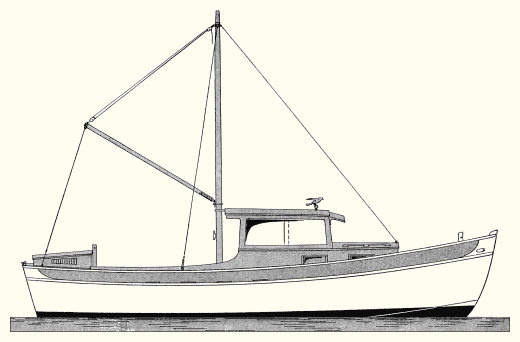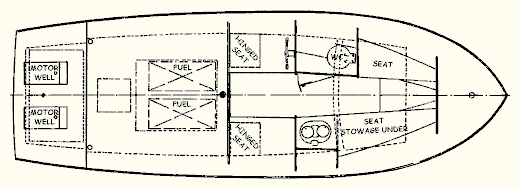

THESE plans were prepared to produce a shipshape, wholesome and practical outboard motor cruiser -- a sturdy, able ship with ability to go, within reason, anywhere, anytime despite the weather. Jog-Along has many earmarks of the sea, earmarks proved by many experienced cruising men. She has, for instance, high bulwark rails, self-draining cockpit, trunk cabin house of nautical aspect, pilot house with full headroom, properly visored windows, nautical mooring bitts, king post with boom (for handling the motors), and a little cuddy. There is an enclosed toilet room fitted with the usual amenities. For cooking, and for warmth, there's a wood and coal-burning range. Here, then, we have snugness and comfort.

A small boat built from steel or wrought iron, if cared for, will have as long a life as one of wooden construction; furthermore, in the event of hard usage it will outlast the latter. The metal hull without interior joiner work, tanks, motor installation, deck fittings, and other miscellaneous equipment, will cost less than one of the same size built from wood. Also, and of particular interest, the well-built iron or steel boat will not leak, its seams being few and these permanently watertight. Wrought iron, because of its low carbon count, will outlast steel in either fresh or salt water; it is, however, not as strong. In a large yacht this would be a consideration; in a little one like Jog-Along of little. Steel is easy to get, but where, people may ask, may one buy wrought iron plate, and who rolls this material. An answer to both is A. M. Byers Company, Pittsburgh, Pa., or from one of their dealers.
Jog-Along, is 22' 1" LOA; 20' LWL; 7' 10" breadth; and draws 1' 11" of water. She is a V-bottom model with straight sections from the keel to the corners of the chines and from the chines to the under side of the rail cap; the overhang at the bow is modest and in keeping with the rest of the design. The stern transom has just enough rake to accommodate the screw clamps which anchor the motors in the twin wells. A long skeg is provided, not only to keep the boat on its course, but to serve as a guard against the propellers striking bottom, and to throw off drifting flotsam. The rudder is abaft and between the wells. She has a shapely big hull for her outside dimensions and consequently unusual room on deck, in the cabin, and cockpit. The bulwark rails are 10" high at the bow, tapering in an easy sweep to 6 1/2" at the stern. Freeboard forward is 3' 10 3/4", 2' 4 3/8" aft and 2' 2" at the lowest point. The trunk cabin house provides light and ventilation to the accommodations below. Her pilot house, raised from the cabin trunk, has windows on both sides and in the forward end; the after end is open.
The motors are two 18 hp outboard units designed to drive Jog-Along at a comfortable 12 mph; propellers turning in wells are installed in the after compartment under a raised hatch; access to these is through the double covers. A watertight bulkhead between stations 10 and 11 separates the motor space from the cockpit, a precaution against water finding its way forward in case of sloppage over the tops of the propeller wells. There should be a bilge sump abaft the bulkhead piped to a hand-operated pump in the cockpit -- just in case. The motors will be fixed and not used for steering; a single rudder under the stern performs this service. An Aqua-Guide steerer takes care of the operation of the tiller, which is between the twin wells; and a similar device for the motor controls which, of course, are in easy reach of the helmsman.
Two gasoline tanks, made from galvanized iron, will have a total capacity of 44 gallons; they will be filled from the deck. Installation of the tanks is below the cockpit floor, close enough to the midship area of the hull so it doesn't badly affect the boat's trim when full or empty. In so small a boat as this with two for crew and anticipating only overnight cruising, the fresh-water problem is solved best by two five-gallon jugs. At the sacrifice of space in the forepeak, a 10 to 12-gallon galvanized-iron water tank might be fitted just forward of the low bulkhead, not allowing the top of the tank to project above this. Then pipe to a convenient outlet. I would not advise copper tanks in an iron or steel hull; copper and iron or steel are not happy shipmates.

Her cabin is 6' 4" long; the toilet room is 2' 9" long and is fitted with the smallest size pump water closet, headroom is 4' 3"; there is room beneath the waist deck for two shelves and on the bulkhead for a mirror; a seat on this side is 4' 6" long; there is comfortable sitting up headroom over this.
The opposite side gives room for a small wood and coal-burning range, coal and wood stowage bin and a seat 4' 6" long. Under both these seats there is stowage space and room for a long shelf, and forward of both a forecastle. Headroom in the cabin is 4' 3" clear, just right for sitting. The after end of the pilot house or standing top is 3' long, its forward end projecting over the trunk cabin top, with cabin doors in the bulkhead. The cabin floor extends on nearly one level from the forward bulkhead to the after end of the pilot house, a length of 9' 4" by a width of from 20" to 26".
The cockpit floor is 4 1/2" above the load water line and is self-draining; a well in the floor forward, 3' long by 26" wide, provides full standing room. The steering wheel and motor controls are within easy reach of the position. There is a hinged seat on each side, and vision is excellent all around. A large flush hatch is located over the tanks, and a smaller one abaft it to make inspection of the bilge easy.
Because we believe room in the interior, during the day, is more important than cluttering the cabin with bunks, we decided to use air mattresses for sleeping; one to port and the other to starboard, and simply laid on the cockpit floor, close up to the cabin bulkhead. One half the length of these will be covered by the pilot house overhead, the after ends protected from the elements by a removable khaki awning spread over the derrick boom, and its edges made watertight against the outside of the coamings. Provision is made on the king post to raise the forward end and permit the after to be lowered to drain rainwater from the cockpit floor.

The hull and the deck of Jog-Along are made from iron as already mentioned; the deckhouse, hatches, cockpit floor, and interior Joiner work from vinyl plywood with the more usual and old-fashioned boatbuilding woods for framing. If you expect the little packet to trim and perform properly do not use heavy woods like oak, mahogany, teak, yellow pine except where specified. And use vinyl plywood where plywood is specified. Do not increase thicknesses indicated on the plans.